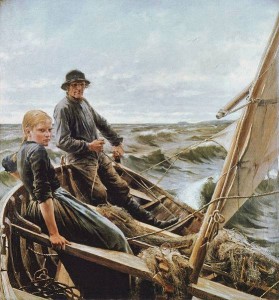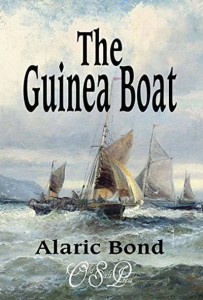
Merellä” (At Sea)
Oil on canvas by Albert Edelfelt, a Finnish artist, in 1883. Thanks to Curtis William Erling White and Barista Uno, shipmates aboard All Things Nautical, a Facebook group.
The year is 1803 and times is hard in Hastings. Sometimes a young man’s got to do what a man’s got to do. And so does a young woman..
Alaric Bond’s latest novel, The Guinea Boat (Old Salt Press) is about two English youths on the cusp of adulthood during the Peace of Amiens, a short-lived lull in hostility between England and France. But the so-called “peace” was not exactly tranquil. The reader experiences the intersecting lives of Nat, a somewhat arrogant but likeable lad from Ninfield in Sussex, who leaves home and an unexciting future as a bookkeeper in his father’s accounting business to find a more successful life at sea. Lighting out for Rye, he is waylaid in Hastings where he meets Alex, son of a revenue man and becomes an unlikely apprentice, crewing for Ned Coglan, a local fisherman and widower with two teenaged daughters.
The story is told from alternating viewpoints of Nat and Alex, whose lives become intertwined, then go off on different tacks. Smugglers, revenue men, merchantmen, the navy, the Sea Fencibles, and three young lassies are all at work — and often at odds — in this convincing historical novel.
The Guinea Boat is filled with conflict and the plot has some good twists, but what I really appreciated was the setting — the strong sense of time and place created through well chosen details. Bond creates his maritime settings convincingly by steeping himself in his place, as is evidenced by his blog post.
Before publication Alaric and I discussed The Guinea Boat’s potential market. Is it for teens? Certainly young adults will relate to the youthful protagonists who make some rash decisions. But the book will appeal to older readers as well, as it is written from an older, wiser man’s perspective — a man looking back on his youth with satisfaction, pride, and regret. In fact Nat begins the tale with “There is much I would change now…”
Coming of age novels interest me. As do sea stories and historical settings. Combine the three and I’m hooked.
